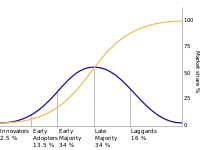
Photo from wikipedia
The aim of the study was to compare the diagnostic accuracy of different diffusion patterns for differentiation between treatment-related lesions and true tumor progression in patients with suspected glioma recurrence.… Click to show full abstract
The aim of the study was to compare the diagnostic accuracy of different diffusion patterns for differentiation between treatment-related lesions and true tumor progression in patients with suspected glioma recurrence. A retrospective analysis of a prospective cohort was conducted. The images of 240 consecutive patients who underwent surgery for suspected glioma recurrence were reviewed for potential inclusion. Exclusion criteria were lack of a ring-enhancing lesion and presence of susceptibility artifact. Final diagnosis was established upon review of histopathology reports. Lesions showing treatment-related changes and less than 25% of viable tumor were considered treatment-related lesions. More than 25% of viable tumor was considered recurrent tumor. A neuroradiologist, blinded to the diagnosis, evaluated the diffusion patterns on preoperative MRI. ROC curve analysis was performed. One hundred and ten patients were included (26 with treatment-related lesions and 84 with tumor progression). Of 110, 35 showed no reduced diffusion. Fifty patients had reduced diffusion in the solid lesion component (84%, recurrent tumor and 16%, treatment-related lesions). Twenty-five patients showed reduced diffusion within the central necrosis (48%, recurrent tumor and 52%, treatment-related lesions). Most cases with reduced diffusion in the central necrotic region showed mixed pathology with concurrent treatment effect and viable tumor. The AUC for the combined diffusion pattern (reduced diffusion in the solid lesion component vs in the necrotic region) was 0.68 (95%CI=0.55–0.81). The AUC for the traditional diffusion approach (reduced diffusion in the solid lesion component vs no reduced diffusion) was 0.59 (95%CI=0.49–070). No significant differences were found in AUC (p=0.3). Although the existence of centrally reduced diffusion seems to be associated with the presence of treatment effect, it does not significantly increase the diagnostic accuracy of the traditional diffusion evaluation approach. This is most likely related to the high incidence of concurrent recurrent tumor and treatment effect.
Journal Title: Neuro-Oncology
Year Published: 2019
Link to full text (if available)
Share on Social Media: Sign Up to like & get
recommendations!